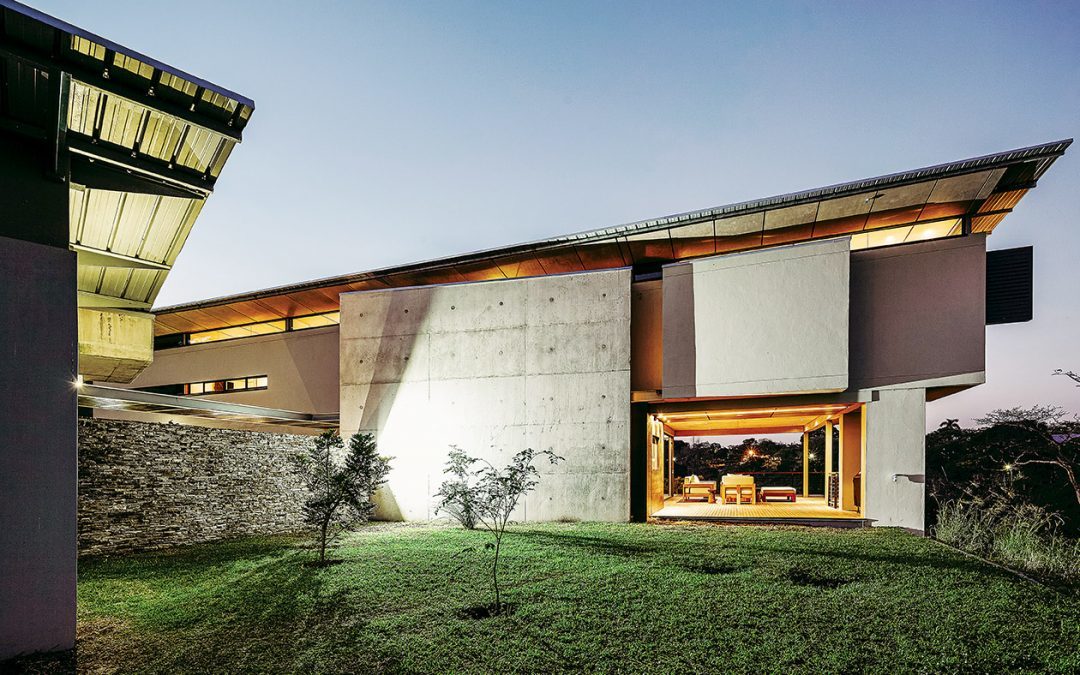location: Westville, KwaZulu-Natal | architecture: Elphick Proome Architects | interior design: novospace & Karin Elphick | photography: Karl Beath
This contemporary build of 800 square metres is sited on 11 000 square metres of what was vacant land, now zoned for multiple villas and bordering a nature reserve. It was carefully planned for the relocation of a young family into the community and lifestyle in which the owner was raised.
- architecture: Elphick Proome Architects | interior design: novospace & Karin Elphick | photography: Karl Beath
This was a new house on a partially platformed site in Westville North. A substantial piece of land was procured with a view to developing additional homes in the future. It’s a location offering extraordinary views of the Palmiet Nature Reserve, but provides the opportunity for the three young children to walk to and from the local school.
Say the architects: ‘A lengthy and productive engagement with the couple yielded an interesting brief, which was to include house, guest studio and ancillary accommodation. Of paramount importance from the outset was respect for the environment, with a particular directive to create a home, which – while large in scale – would display a relatively understated architectural character.
- architecture: Elphick Proome Architects | interior design: novospace & Karin Elphick | photography: Karl Beath
‘Prerequisites were a level garden on which to play cricket, a courtyard to promote tennis practice and a pool large enough for swimming training. Others were open, permeable living spaces with a focal kitchen as the centroid of the house, together with four interesting bedrooms. The family shares a love for the African bush and this drove the requirement for extensive outdoor connectivity, selected materiality and interior furnishings.’
- architecture: Elphick Proome Architects | interior design: novospace & Karin Elphick | photography: Karl Beath
Considering the long-term opportunity to densify the site, there were various options for siting the house. A crucial driver in this decision was to ensure that the remarkable location was fully embraced. So the choice to position the building on the southern edge of the land with a long driveway provided the best prospect with unfettered views to the verdant eastern valley, dramatic cliff faces and northern aspect across the land. As the ground slopes variously, it was decided to capitalise on the use of an existing platform and this also enhanced the opportunity to ‘settle’ the building into what will ultimately become an extension of the adjacent nature reserve, complete with indigenous wildlife.
The architects add that simple planning and a two-level arrangement with sleeping spaces above and living spaces below were early decisions. And that this, resolved into a rectangular planform, delivers an anchor to which the ancillary accommodation is appended.
- architecture: Elphick Proome Architects | interior design: novospace & Karin Elphick | photography: Karl Beath
They continue: ‘The design intention was to create a truly African home with a sensitive contextual integration into a large site. Our clients exhibited a strong desire to deploy simple sustainability methods. This, together with an appreciation of the local microclimate, orientation and rectangular planform with dominant edges facing north, was first principle architectural responses.
- architecture: Elphick Proome Architects | interior design: novospace & Karin Elphick | photography: Karl Beath
- architecture: Elphick Proome Architects | interior design: novospace & Karin Elphick | photography: Karl Beath
‘A strategy to use large over-sailing roofs in conjunction with a suspended, elevated veranda structure and sliding folding shutters generated the basis of the passive climatic response and was invoked conceptually at the outset. The filter solution to the envelope has proved highly successful and is extensively used to generate privacy, security and to promote cooling. Air-conditioning was entirely discarded in favour of natural ventilation and the inclusion of greywater treatment, extensive rainwater harvesting from a large central gutter and a PV array on the roof to serve essential appliances were introduced as active solutions. The integration of these elements serves the house well, both functionally and in terms of liveability.
- architecture: Elphick Proome Architects | interior design: novospace & Karin Elphick | photography: Karl Beath
‘The essence of the interior signature was to create spaces which directly responded to the owner’s love of Africa and particularly the African bushveld. This informed the selection of neutral earthy colours for furniture and fabrics to complement the raw concrete and extensive timber work that generates the architecture.
‘Simplicity was a key driver in the choice of understated pieces juxtaposed with soft accents in blues and greens. African artwork was selectively deployed to deliver pointed focus in the living spaces, while furniture and objects in the children’s spaces introduce a quality of fun and playfulness. Quiet, informal yet structured interiors have been created and are enjoyed by family and friends alike.’
- architecture: Elphick Proome Architects | interior design: novospace & Karin Elphick | photography: Karl Beath










